The Philippines vowed yesterday to fight China “to the last man standing,” as a Chinese warship patrolled around a remote reef occupied by a handful of Philippine Marines in disputed waters.
In the latest flare-up over competing claims to parts of the South China Sea, the Philippines this week denounced the “provocative and illegal presence” of the warship and a fleet of Chinese fishing vessels near the Second Thomas Shoal.
After China brushed off the protest and insisted it owned the tiny reef and islets, which are home to rich fishing grounds, the Philippines yesterday ramped up the rhetoric against its much more powerful rival.
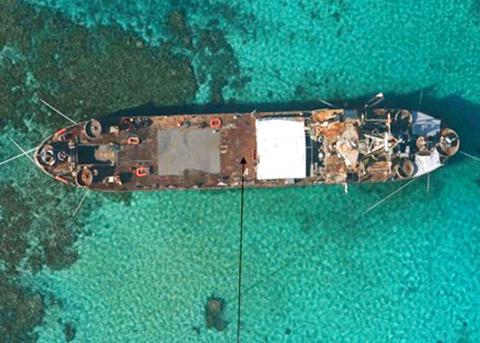
PHOTO: AFP
“To the last soldier standing, we will fight for what is ours,” Philippine Secretary of Defense Voltaire Gazmin told reporters when asked if the Philippines would bow to Chinese intimidation and pull its forces from the shoal.
However, Gazmin said the Philippines was not intending to send any military reinforcements to the area, and that there had been no confrontations between the two sides at the shoal since the Chinese vessels arrived early this month.
Second Thomas Shoal is one of nine Philippine-occupied islands or islets in the Spratly Islands (Nansha Islands, 南沙群島), which Taiwan also claims.
It lies about 200km northwest of the Philippine island of Palawan, the nearest major landmass, and more than 1,000km from China’s Hainan Island.
The shoal is guarded by a handful of Philippine Marines, believed to number fewer than 10, aboard a World War II-era ship that was deliberately grounded there in the late 1990s to serve as a base.
China says it has sovereign rights over nearly all of the South China Sea, even waters far away from its main landmass and approaching the coasts of Southeast Asian countries.
Taiwan, the Philippines, Vietnam, Malaysia and Brunei also claim parts of the sea, and the area has for decades been regarded as a potential trigger for major military conflict in the region.
All claimants, except Brunei, have troops stationed on various islands and atolls in the Spratlys — the biggest archipelago in the sea — to assert their claims.
Regional tensions have escalated in recent years as China has taken more aggressive steps to assert its claims to the sea, which is believed to sit atop vast reserves of oil and gas worth billions of US dollars.
China has established a new city to oversee the area and deployed navy vessels on wide-ranging patrols of the sea, with its ships reaching as far as 80km from Malaysia.
China last year also took control of the Scarborough Shoal, known as Huangyan Island (黃岩島) in China and Taiwan, which both claim it. Another bountiful fishing area far closer to the Philippine landmass than China’s, after a stand-off between vessels from both nations ended with the Philippines retreating.
Second Thomas Shoal is 40km east of Mischief Reef (Meiji Reef, 美濟礁), a Philippine-claimed outcrop China has occupied since 1995.
Second Thomas Shoal and Mischief Reef are within the Philippines’ internationally recognized exclusive economic zone.
“They should not be there. They do not have the right to be there,” Philippine Department of Foreign Affairs spokesman Raul Hernandez said via text message yesterday when asked about the Chinese presence at Second Thomas Shoal. “No one should doubt the resolve of the Filipino people to defend what is ours in that area.”
Philippine President Benigno Aquino III on Tuesday announced a planned US$1.8 billion military upgrade to defend the country’s maritime territory against “bullies.”
However, China’s announced defense budget of US$115 billion this year is nearly 100 times that of the Philippines.
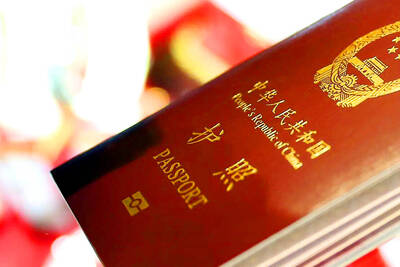
The Ministry of the Interior (MOI) is to tighten rules for candidates running for public office, requiring them to declare that they do not hold a Chinese household registration or passport, and that they possess no other foreign citizenship. The requirement was set out in a draft amendment to the Enforcement Rules of the Public Officials Election and Recall Act (公職人員選舉罷免法 ) released by the ministry on Thursday. Under the proposal, candidates would need to make the declaration when submitting their registration forms, which would be published in the official election bulletin. The move follows the removal of several elected officials who were
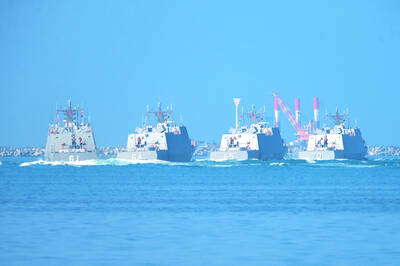
FOUR DESIGNATED AREAS: Notices were issued for live-fire exercises in waters south and northwest of Penghu, northeast of Keelung and west of Kaohsiung, they said The military is planning three major annual exercises across the army, navy and air force this month, with the navy’s “Hai Chiang” (海強, “Sea Strong”) drills running from today through Thursday, the Ministry of National Defense said yesterday. The Hai Chiang exercise, which is to take place in waters surrounding Taiwan, would feature P-3C Orion maritime patrol aircraft and S-70C anti-submarine helicopters, the ministry said, adding that the drills aim to bolster the nation’s offshore defensive capabilities. China has intensified military and psychological pressure against Taiwan, repeatedly sending warplanes and vessels into areas near the nation’s air defense identification zone and across
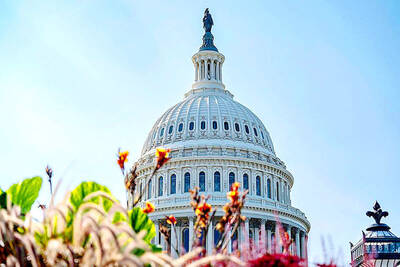
SENATE RECOMMENDATION: The National Defense Authorization Act encourages the US secretary of defense to invite Taiwan’s navy to participate in the exercises in Hawaii The US Senate on Thursday last week passed the National Defense Authorization Act (NDAA) for Fiscal Year 2026, which strongly encourages the US secretary of defense to invite Taiwan’s naval forces to participate in the Rim of the Pacific (RIMPAC) exercise, as well as allocating military aid of US$1 billion for Taiwan. The bill, which authorizes appropriations for the military activities of the US Department of Defense, military construction and other purposes, passed with 77 votes in support and 20 against. While the NDAA authorizes about US$925 billion of defense spending, the Central News Agency yesterday reported that an aide of US
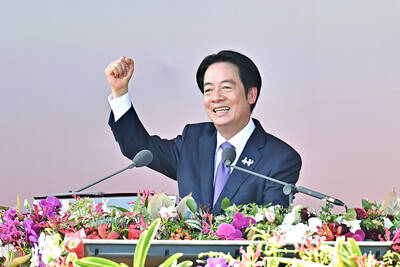
NATIONAL DAY: The ‘Taiwan Dome’ would form the centerpiece of new efforts to bolster air defense and be modeled after Israel’s ‘Iron Dome,’ sources said President William Lai (賴清德) yesterday pledged to strengthen the nation’s air defense capabilities and build a “T-Dome” system to create a safety net against growing military threats from China. “We will accelerate our building of the T-Dome, establish a rigorous air defense system in Taiwan with multi-layered defense, high-level detection and effective interception, and weave a safety net for Taiwan to protect the lives and property of citizens,” he said in his National Day address. In his keynote address marking the Republic of China’s (ROC) 114th anniversary, Lai said the lessons of World War II have taught nations worldwide “to ensure that